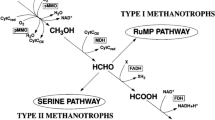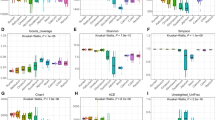Abstract
To enrich an effective Chinese cabbage waste-anaerobic digesting microorganism community, a mixture of cellulolytic microbial community, anaerobic straw-digesting sludge, and cow dung was loaded in a continuous stirred tank reactor, and the Chinese cabbage wastes were fed as carbon and nitrogenous sources. The methane conversion efficiency reached 235.6 mL/g VS after 37 days of operation. The average biogas producing yield was 452.6 mL/g VS with 10.1 g/(L day) of organic loading rate between day 213 and day 231. This microorganism community could effectively degrade Chinese cabbage waste and filter paper, and the weight losses were 72.6 ± 1.1% and 91.4 ± 2.4% in 7 days, respectively. This microorganism community was further analyzed by high-throughput sequencing of the 16S rRNA gene and shown to have abundant bacterial diversity, but poor archaeal diversity. Longilinea, Candidatus Cloacamonas, and Caldisericum were the top three classes of abundant bacterial community, and the proportional abundances were 7.0%, 5.5%, 3.6%, respectively. Methanothrix and Methanolinea dominated the methanogenic archaeal community and occupied 90.8% proportion of total archaeal abundance.






Similar content being viewed by others
References
Askci Consulting (2017) The Research Report on the market prospect of Chinese cabbage in 2017. http://www.sohu.com/a/209730098_350221
Choi MH, Park YH (2003) Production of yeast biomass using waste Chinese cabbage. Biomass Bioenerg 25(2):221–226
Choi MH, Ji GE, Koh KH, Ryu YW, Jo DH, Park YH (2002) Use of waste Chinese cabbage as a substrate for yeast biomass production. Bioresour Technol 83(3):251–253
Zuo Z, Wu S, Zhang W, Dong R (2013) Effects of organic loading rate and effluent recirculation on the performance of two-stage anaerobic digestion of vegetable waste. Bioresour Technol 146:556–561
Wills RBH, Wong AWK, Scriven FM, Greenfield H (1984) Nutrient composition of Chinese vegetables. J Agric Food Chem 32(2):413–416
Ros M, de Souza Oliveira Filho J, Perez Murcia MD, Bustamante MA, Moral R, Coll MD, Lopez Santisima-Trinidad AB, Pascual JA (2017) Mesophilic anaerobic digestion of pig slurry and fruit and vegetable waste: dissection of the microbial community structure. J Clean Prod 156:757–765
Jiang Y, Heaven S, Banks CJ (2012) Strategies for stable anaerobic digestion of vegetable waste. Renew Energy 44:206–214
Bouallagui H, Torrijos M, Godon JJ, Moletta R, Ben Cheikh R, Touhami Y, Delgenes JP, Hamdi M (2004) Two-phases anaerobic digestion of fruit and vegetable wastes: bioreactors performance. Biochem Eng J 21(2):193–197
Raynal J, Delgenès JP, Moletta R (1998) Two-phase anaerobic digestion of solid wastes by a multiple liquefaction reactors process. Bioresour Technol 65(1):97–103
Rajeshwari KV, Lata K, Pant DC, Kishore VVN (2001) A novel process using enhanced acidification and a UASB reactor for biomethanation of vegetable market waste. Waste Manag Res 19(4):292–300
Lin J, Zuo J, Gan L, Li P, Liu F, Wang K, Chen L, Gan H (2011) Effects of mixture ratio on anaerobic co-digestion with fruit and vegetable waste and food waste of China. J Environ Sci 23(8):1403–1408
Velmurugan B, Alwar Ramanujam R (2011) Anaerobic digestion of vegetable wastes for biogas production in a fed-batch reactor. Int J Emerg Sci 1(3):478–486
Gulhane M, Khardenavis AA, Karia S, Pandit P, Kanade GS, Lokhande S, Vaidya AN, Purohit HJ (2016) Biomethanation of vegetable market waste in an anaerobic baffled reactor: effect of effluent recirculation and carbon mass balance analysis. Bioresour Technol 215:100–109
Bouallagui H, Touhami Y, Ben Cheikh R, Hamdi M (2005) Bioreactor performance in anaerobic digestion of fruit and vegetable wastes. Process Biochem 40(3):989–995
Haruta S, Cui Z, Huang Z, Li M, Ishii M, Igarashi Y (2002) Construction of a stable microbial community with high cellulose-degradation ability. Appl Microbiol Biot 59(4):529–534
Lü Y, Li N, Gong D, Wang X, Cui Z (2012) The effect of temperature on the structure and function of a cellulose-degrading microbial community. Appl Biochem Biotech 168(2):219–233
O’Sullivan CA, Burrell PC, Clarke WP, Blackall LL (2005) Structure of a cellulose degrading bacterial community during anaerobic digestion. Biotechnol Bioeng 92(7):871–878
Kato S, Haruta S, Cui ZJ, Ishii M, Yokota A, Igarashi Y (2004) Clostridium straminisolvens sp. nov., a moderately thermophilic, aerotolerant and cellulolytic bacterium isolated from a cellulose-degrading bacterial community. Int J Syst Evol Microbiol 54(6):2043–2047
Collins MD, Lawson PA, Willems A, Cordoba JJ, Fernandez-Garayzabal J, Garcia P, Cai J, Hippe H, Farrow JAE (1994) The phylogeny of the genus Clostridium: proposal of five new genera and eleven new species combinations. Int J Syst Evol Microbiol 44(4):812–826
Zhang X, Tu B, Dai L, Lawson PA, Zheng Z, Liu LY, Deng Y, Zhang H, Cheng L (2018) Petroclostridium xylanilyticum gen. nov., sp. nov., a xylan-degrading bacterium isolated from an oilfield, and reclassification of clostridial cluster III members into four novel genera in a new Hungateiclostridiaceae fam. nov. Int J Syst Evol Microbiol 68(10):3197–3211
Tatsuya N, Ginro E, Juu-En C, Jun-Ichi Y, Jun-Ichiro M (1985) Characteristics of carbohydrate degradation and the rate-limiting step in anaerobic digestion. Biotechnol Bioeng 27(10):1482–1489
APHA (1998) Standard methods for the examination of water and wastewater, 20th. APHA, Washington, DC
Yao Y, Lv Y, Li N, Guo J, Tian Y, Gong DG (2017) Study on fermentation characteristics of yeast wastewater treated by biofilm reactor. J China Agric Univ 22(8):133–144
Herlemann DPR, Labrenz M, Jürgens K, Bertilsson S, Waniek JJ, Andersson AF (2011) Transitions in bacterial communities along the 2000 km salinity gradient of the Baltic Sea. ISME J 5:1571–1579
Takai K, Horikoshi K (2000) Rapid detection and quantification of members of the archaeal community by quantitative PCR using fluorogenic probes. Appl Environ Microbiol 66(11):5066–5072
Gao X, Gao W, Cui Z, Han B, Yang P, Sun C, Zheng L (2015) Biodiversity and degradation potential of oil-degrading bacteria isolated from deep-sea sediments of South Mid-Atlantic Ridge. Mar Pollut Bull 97(1):373–380
Schloss PD, Gevers D, Westcott SL (2011) Reducing the effects of pcr amplification and sequencing artifacts on 16S rRNA-based studies. PLoS One 6(12):e27310
Lemos LN, Fulthorpe RR, Triplett EW, Roesch LFW (2011) Rethinking microbial diversity analysis in the high throughput sequencing era. J Microbiol Methods 86(1):42–51
Bouallagui H, Ben Cheikh R, Marouani L, Hamdi M (2003) Mesophilic biogas production from fruit and vegetable waste in a tubular digester. Bioresour Technol 86(1):85–89
Kafle GK, Bhattarai S, Kim SH, Chen L (2014) Effect of feed to microbe ratios on anaerobic digestion of Chinese cabbage waste under mesophilic and thermophilic conditions: biogas potential and kinetic study. J Environ Manag 133:293–301
Sun L, Liu T, Müller B, Schnürer A (2016) The microbial community structure in industrial biogas plants influences the degradation rate of straw and cellulose in batch tests. Biotechnol Biofuels 9(1):128
Crawford DL, Crawford RL (1976) Microbial degradation of lignocellulose: the lignin component. Appl Environ Micro 31(5):714–717
Wu W, Chen Y, Faisal S, Khan A, Chen Z, Ling Z, Liu P, Li X (2016) Improving methane production in cow dung and corn straw co-fermentation systems via enhanced degradation of cellulose by cabbage addition. Sci Rep UK 6:33628
Brown D, Shi J, Li Y (2012) Comparison of solid-state to liquid anaerobic digestion of lignocellulosic feedstocks for biogas production. Bioresour Technol 124:379–386
Lo Liew N, Shi J, Li Y (2012) Methane production from solid-state anaerobic digestion of lignocellulosic biomass. Biomass Bioenerg 46:125–132
Yamada T, Imachi H, Ohashi A, Harada H, Hanada S, Kamagata Y, Sekiguchi Y (2007) Bellilinea caldifistulae gen. nov., sp. nov. and Longilinea arvoryzae gen. nov., sp. nov., strictly anaerobic, filamentous bacteria of the phylum Chloroflexi isolated from methanogenic propionate-degrading consortia. Int J Syst Evol Microbiol 57(10):2299–2306
Pelletier E, Kreimeyer A, Bocs S, Rouy Z, Gyapay G, Chouari R, Rivière D, Ganesan A, Daegelen P, Sghir A, Cohen GN, Médigue C, Weissenbach J, Le Paslier D (2008) “Candidatus Cloacamonas Acidaminovorans”: genome sequence reconstruction provides a first glimpse of a new bacterial division. J Bacteriol 190(7):2572–2579
Mori K, Yamaguchi K, Sakiyama Y, Urabe T, Suzuki K (2009) Caldisericum exile gen. nov., sp. nov., an anaerobic, thermophilic, filamentous bacterium of a novel bacterial phylum, Caldiserica phyl. nov., originally called the candidate phylum OP5, and description of Caldisericaceae fam. nov., Caldisericales ord. nov. and Caldisericia classis nov. Int J Syst Evol Microbiol 59(11):2894–2898
Manaia CM, Nogales B, Nunes OC (2003) Tepidiphilus margaritifer gen. nov., sp. nov., isolated from a thermophilic aerobic digester. Int J Syst Evol Microbiol 53(5):1405–1410
Zinder SH, Sowers KR, Ferry JG (1985) NOTES: Methanosarcina thermophila sp. nov., a thermophilic, acetotrophic, methane-producing bacterium. Int J Syst Evol Microbiol 35(4):522–523
Huser BA, Wuhrmann K, Zehnder AJB (1982) Methanothrix soehngenii gen. nov. sp. nov., a new acetotrophic non-hydrogen-oxidizing methane bacterium. Arch Microbiol 132(1):1–9
Sakai S, Ehara M, Tseng I-C, Yamaguchi T, Bräuer SL, Cadillo-Quiroz H, Zinder SH, Imachi H (2012) Methanolinea mesophila sp. nov., a hydrogenotrophic methanogen isolated from rice field soil, and proposal of the archaeal family Methanoregulaceae fam. nov. within the order Methanomicrobiales. Int J Syst Evol Microbiol 62(6):1389–1395
Imachi H, Sakai S, Sekiguchi Y, Hanada S, Kamagata Y, Ohashi A, Harada H (2008) Methanolinea tarda gen. nov., sp. nov., a methane-producing archaeon isolated from a methanogenic digester sludge. Int J Syst Evol Microbiol 58(1):294–301
Huber R, Dyba D, Huber H, Burggraf S, Rachel R (1998) Sulfur-inhibited Thermosphaera aggregans sp. nov., a new genus of hyperthermophilic archaea isolated after its prediction from environmentally derived 16S rRNA sequences. Int J Syst Evol Microbiol 48(1):31–38
Ferry JG, Smith PH, Wolfe RS (1974) Methanospirillum, a new genus of methanogenic bacteria, and characterization of Methanospirillum hungatii sp. nov. Int J Syst Evol Microbiol 24(4):465–469
Sowers KR, Baron SF, Ferry JG (1984) Methanosarcina acetivorans sp. nov., an acetotrophic methane-producing bacterium isolated from marine sediments. Appl Environ Micro 47(5):971–978
Acknowledgements
This work was supported by the National Natural Science Foundation of China (Grant nos. 31500422, 21776162 and 31370506), the Major Technological Innovation Project in Hubei Province of China (Grant no. 2017ABA157) and the National Key Research and Development Projects of China (Grant no. 2016YFD0800902).
Author information
Authors and Affiliations
Corresponding authors
Additional information
Publisher's Note
Springer Nature remains neutral with regard to jurisdictional claims in published maps and institutional affiliations.
Electronic supplementary material
Below is the link to the electronic supplementary material.
Rights and permissions
About this article
Cite this article
Gong, Y., Lyu, Y., Li, P. et al. Characterization of anaerobic digestion of Chinese cabbage waste by a thermophilic microorganism community. J Mater Cycles Waste Manag 21, 1144–1154 (2019). https://doi.org/10.1007/s10163-019-00865-x
Received:
Accepted:
Published:
Issue Date:
DOI: https://doi.org/10.1007/s10163-019-00865-x




